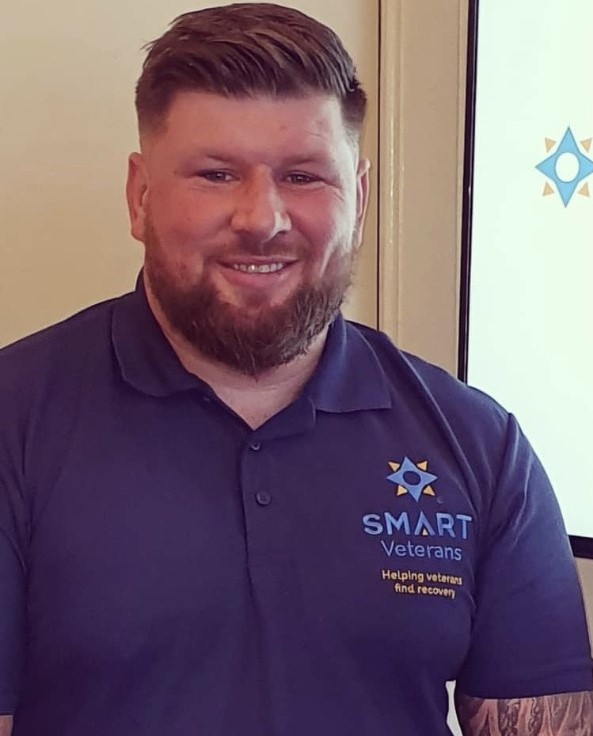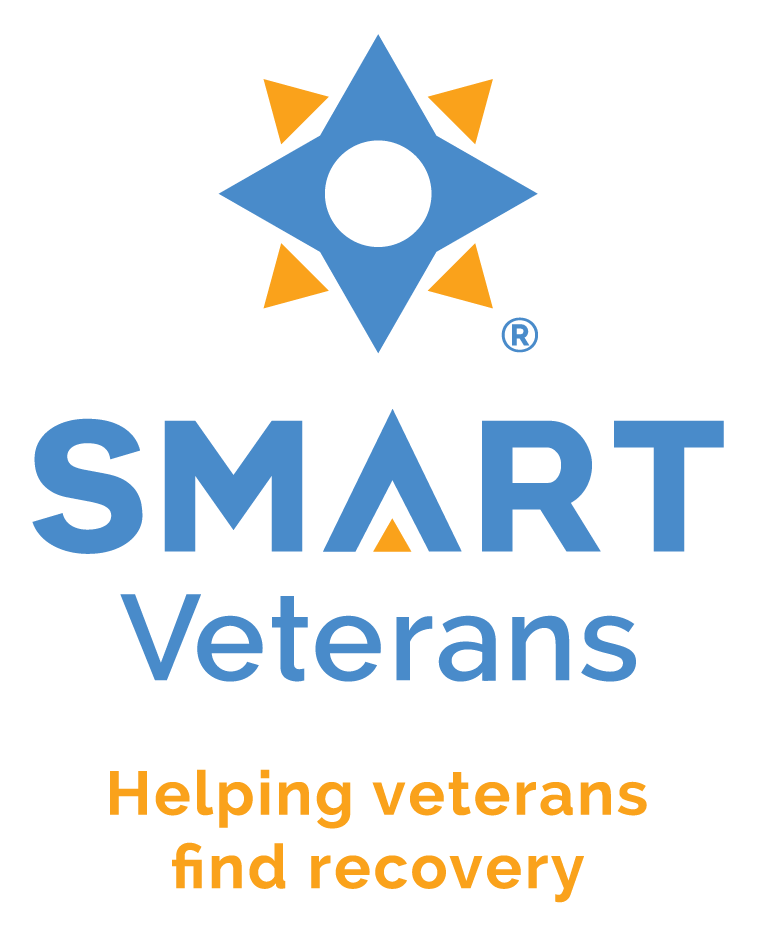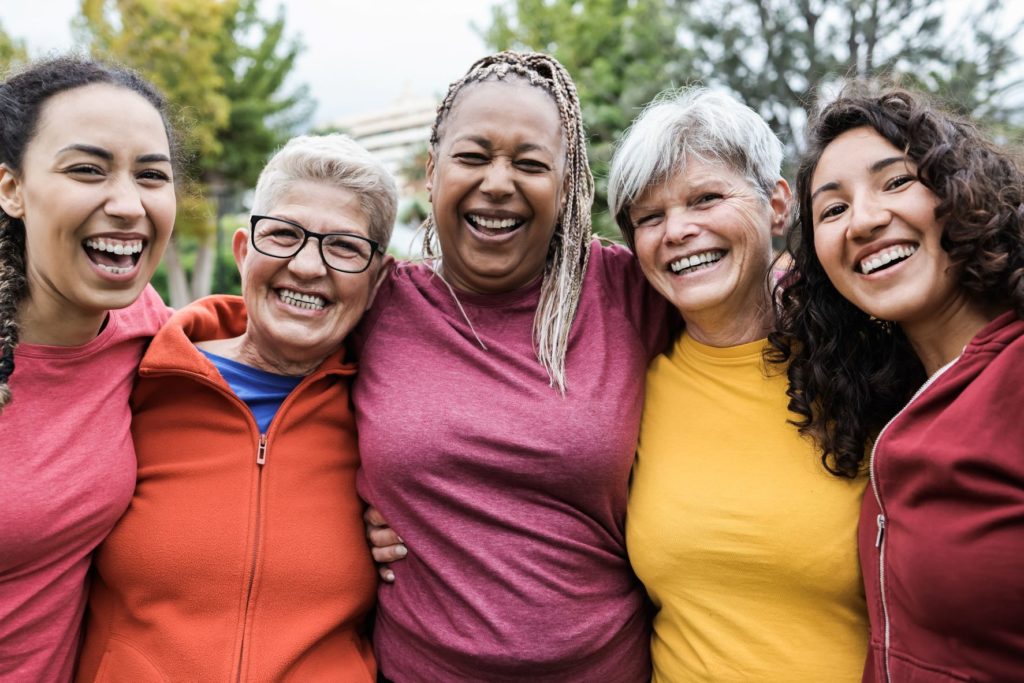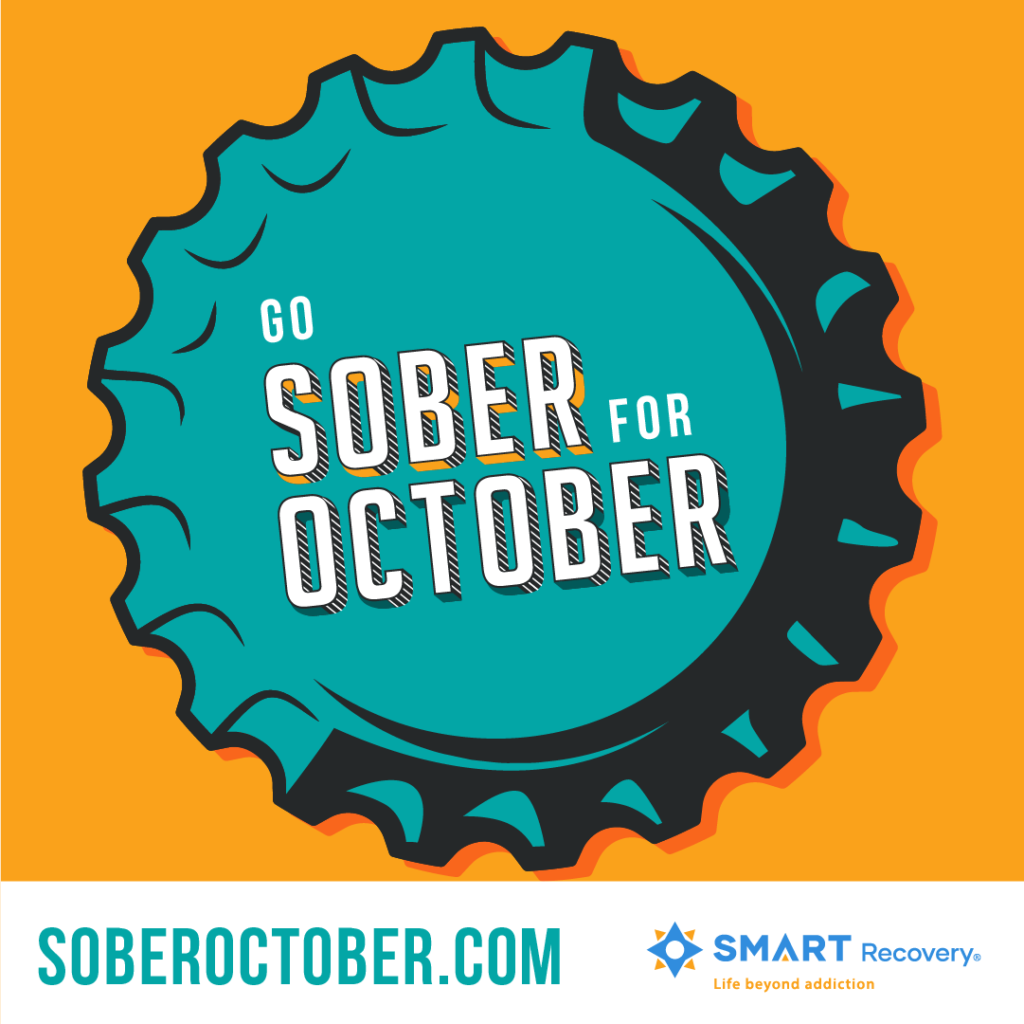Johnny Allison’s substance use started as a way to cope with the trauma of war and chaos of military life. His recovery started as a way to become the soldier and person he knew he was and could be. Today, he is a Veteran, SMART Facilitator, and the Lead of the SMART UK Veterans Program.
In this podcast, Johnny talks about:
- What motivated him to join the British Army
- The ties between his boxing career and serving in the military
- Why his substance use started and not understanding what was happening
- How the COVID isolation affected his mental health and well being
- How he was becoming a shadow of himself
- His drive and commitment to finally getting help
- Finding SMART and how it helped him manage his thoughts, feelings, and behaviors
- Why he wanted to become a facilitator
- Creating the 1st Annual International Veterans and First Responders Webinar
- The best things about attending a Veterans meeting
Additional resources:
Click here to find all of SMART Recovery’s podcasts
PLEASE NOTE BEFORE YOU COMMENT:
SMART Recovery welcomes comments on our blog posts—we enjoy hearing from you! In the interest of maintaining a respectful and safe community atmosphere, we ask that you adhere to the following guidelines when making or responding to others’ comments, regardless of your point of view. Thank you.
- Be kind in tone and intent.
- Be respectful in how you respond to opinions that are different than your own.
- Be brief and limit your comment to a maximum of 500 words.
- Be careful not to mention specific drug names.
- Be succinct in your descriptions, graphic details are not necessary.
- Be focused on the content of the blog post itself.
If you are interested in addiction recovery support, we encourage you to visit the SMART Recovery website.
IMPORTANT NOTE:
If you or someone you love is in great distress and considering self-harm, please call 911 for immediate help, or reach out to 988 Suicide & Crisis Lifeline @ 988, https://988lifeline.org/
We look forward to you joining the conversation!
*SMART Recovery reserves the right to not publish comments we consider outside our guidelines.*


Addiction to alcohol or other drugs is not always easy to recover from. However, there are many pathways to recovery, including through treatment. One group of patients does far better than most other groups. In fact, their results are so impressive that many commentators have urged us to learn from what’s different about their treatment and follow-up to see if we can transfer learning and experience. This group, claim researchers, sets the standard for addiction treatment. Indeed, it represents gold standard addiction treatment. Who are this group? They are doctors and I am one of them.
In 2009, in the Journal of Substance Abuse Treatment, Robert DuPont and colleagues published a study that looked at how addicted doctors were cared for in the treatment system and also what their outcomes following treatment were.
The numbers were large. 906 physicians admitted to 16 different state Physicians’ Health Programmes were followed up for five years or longer.
Treatment
The authors accept that doctors generally come to treatment with more resources than the average patient, but they also point out the hazards that doctors face which potentially increase relapse risk. (Exposure to drugs in the workplace.) What was quite different about doctors in the USA is that they generally have access to specifically designed assessment, treatment and monitoring programmes (Physicians’ Health Programmes). These programmes typically evidence long term abstinence outcomes of between 70 – 96%. Since this paper was written a Practitioner Health Programme has been well established and reports similar results. Here’s what the researchers of the 2009 paper say:
For these reasons, the PHPs appeared to represent one of the most sensible and evidence-based approaches to addiction currently available. We reasoned that an examination of this novel care management approach might provide suggestions for optimally organized and delivered addiction treatment — real-world treatment at its best. If there were clear evidence of positive results from this form of care, the findings might provide guidance for improving mainstream treatment efforts.
The features of the Physicians’ Health Programme model
- Doctors sign binding contracts
- Abstinence is the goal
- Weekly doctor-specific mutual aid groups
- Attendance at 12-step mutual aid groups (AA, NA, CA etc)
- The regulatory boards are often avoided if doctors comply
- Extended care (five years)
- Recovery often starts with an active/planned intervention
- This is followed by an intensive residential (or out-patient)
rehab period, usually three months long - Withdrawal from work during treatment
- Active monitoring and care management
- Active family engagement
- Mental & physical health needs assessed
- Active management of relapse
- Random drug and alcohol tests over the five years
The study
16 PHPs participated in the national survey which looked at all admissions (intention to treat) over a six-year period. The case records and lab results of 904 doctors were studied. Most (86%) were male with an average age of 44. Two thirds were married.
Drugs of choice
What drugs were problematic?
The primary drugs of choice reported by these physicians were alcohol (50%), opiates (33%), stimulants (8%), or another substance (9%). Fifty percent reported abusing more than one substance, and 14% reported a history of intravenous drug use. Seventeen percent had been arrested for an alcohol or drug-related offense, and 9% had been convicted on those charges.
Medication Assisted Treatment/OST
For opioid use disorder in the patients of doctors, the gold standard is opiod substitution medication – it’s generally our first line approach because of the evidence base for reducing harms. So, what about this treatment for opiate addiction in doctors? How many of the hundreds of opiate- addicted doctors ended up on methadone? That would be just one, or to put it another way, 0.001% of the sample.
Work
72% of the doctors got back to work. When they looked at doctors who successfully completed the programme, this rose to 91%.
Overall outcomes
Specifically, of the 904 physicians followed, 72% were still licensed and practicing with no indications of substance abuse or malpractice, 5 to 7 years after signing their contracts. In contrast, the PHP process appears to have moved approximately 18% of these physicians out of the practice of medicine through loss of license or pressure to stop practice.
Of the 904, 180 (19%) had a relapse episode and were reported to their licensing boards. However, only 22% of these had any evidence of a second relapse— generally indicating that the intensified treatment and monitoring were successful in maintaining remission.
Nuggets
- This was the largest sample of doctors ever followed and over the longest period
- Doctors use in a similar fashion to everyone else
- 78% of doctors did not have a single positive drug test over the years of monitoriing
- Outcomes did not differ by drug of choice, opiate addicted docs did as well as alcohol dependent docs
- IV drug users did as well as everyone else
- 50% of the doctors were polysubstance abusers
- This research is in keeping with literature before and since
What does this mean for treatment in general?
If we applied the principles and standard of treatment that doctors get to other patients, would we see improved outcomes overall?
Whatever the differences from other populations experiencing SUDs [substance use disorders], it is likely that the successful treatment of physicians with SUDs has important implications for SUD treatment in general. For example, if physicians were found to have significantly better outcomes than other groups when treated for diabetes or coronary artery disease, this would be of great public health interest.

Raising the bar?
‘Recognising that SUDs are disorders with bio-psychosocial components (just like diabetes and coronary artery disease), the relatively high level of success exhibited by physicians whose care is managed by PHP is important with respect to the potential for success in addiction treatment generally. Indeed, the observed rate of success among physicians directly contradicts the common misperception that relapse is both inevitable and common, if not universal, among patients recovering from SUDs.’
They go on to say:
‘Indeed, rather than being a defining characteristic of addiction, the “ inevitable relapse” may be a defining characteristic of the acute care model of biopsychosocial stabilization, which offers an opportunity for recovery initiation but lacks the essential ingredients to achieve recovery maintenance.’
Making all treatment gold-standard
The paper has some suggestions to transfer learning and improve addiction treatment outcomes:
- Adopt the contingency management aspects of PHPs
- Offer frequent random drug testing
- Create tight linkages with 12-step programmes and abstinence standards
- Active management of relapse by intensified treatment and monitoring
- Continuing care approach
- Focus on lifelong recovery
Reflections
The fact that only one doctor ended up on opiate replacement is a remarkable finding. Are there double standards inherent here? Why do doctors so readily turn away from an evidence-based intervention, one they are very happy to prescribe for patients? It is possible that some doctors who would benefit from MAT are not getting access, but with such high abstinence rates over long follow up periods, it’s understandable why the first offer is different.
The expectation is that doctors will make the journey to abstinent recovery, but there seems to be a much lower expectation of their patients. Some argue this is just realistic, but does such ‘realism’ result in poorer outcomes? Is there a mismatch between professional expectations and client goals? I’ve read recently that ‘palliation; is all that we can do for some and been told in the past by a colleague not to buy into the idea that patients will ever get better. Safety considerations have to be paramount and harm reduction at the heart of everything – but when a patient sets abstinence as a goal, could we do better at helping them get there?
This is not about either or; it’s about having options available that don’t depend on your status or your income that help individuals and their families reach the goals that they set, rather than solely the goals that public health sets.
When I came home from treatment and returned to work in General Practice, I was disturbed that every week I was seeing people with substance use disorders that did not have the same options that were offered to me. Not all of them would necessarily need or choose such options, but some of them would and they did not have the means to get to residential treatment. That led me to set up the service I now work in, but that’s another story…
I don’t think there’s much doubt that we could get better outcomes for our clients by raising the bar, introducing hope and increasing the intensity and duration of treatment, actively referring to mutual aid and thinking much more about the bridge from treatment to recovery community support, which is one of the keys to long term recovery.
Should doctors really get better treatment and follow up than the rest of the population? Can we narrow the gap?
Continue the discussion on Twitter: @DocDavidM
DuPont, R., McLellan, A., White, W., Merlo, L., & Gold, M. (2009). Setting the standard for recovery: Physicians’ Health Programs Journal of Substance Abuse Treatment, 36 (2), 159-171 DOI: 10.1016/j.jsat.2008.01.004
This blog was previously published a couple of years ago. It has been lightly edited.
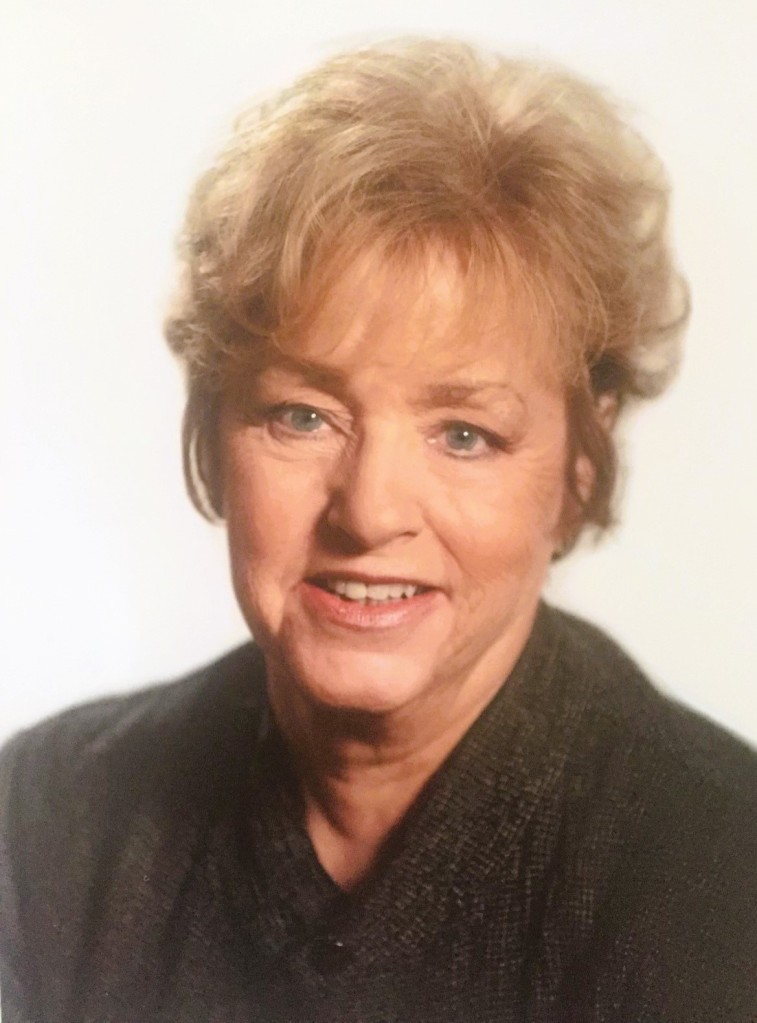
Forward – I have been thinking for some time about the linkages across recovery history. We don’t always do the best job at recording and teaching our own history. It is vital to the future that we understand our own past and how it has shaped our current environment. We must understand where we came from to take the next steps towards our goals. History tends to echo similar themes across time. Recovery in America in our era starts in the late 1930s. Much of what was accomplished originates with Mrs. Marty Mann. When considering our original modern recovery advocate, I knew the person in my network with the one of the longest institutional memories who could provide me insight was Bev Haberle. She generously agreed to this interview.
Accolades for Bev and what she had the foresight to do over the course of her career. When her organization, PRO-Act had received one of the original Recovery Community Support Project (RCSP) grants, she helped preserve a vital chapter in recovery history. Grounding efforts in our own history is an important part of guiding efforts forward. She focused an initial project of the grant on highlighting the work of recovery pioneer Marty Mann. Bev gathered together people who had personal recollections and handwritten notes of Marty and her work. This was occurring as writers were working on a biography of Marty Mann’s life. The authors attended the event and some of those handwritten memories made it into their book. In this way, Bev helped preserve vital facets of recovery history.
Bev also attended one of two services for Marty that were held after her death in 1980. She went to the one in New York at St. Patrick’s Cathedral. There was also one on the west coast. She recounted to me how she and a friend drove to New York to honor this recovery pioneer who changed how the world saw alcoholism. On the drive to NYC, they spoke about the tribute to her life that they would be a part of. They walked into an event that was more sparsely attended than they had hoped. It stuck with Bev as less than what Marty, noted as one of the most important women of the 20th century deserved. We talked about how it may have been that she was a woman or that she was gay, but we agreed that in any proper accounting of modern recovery history in America, Marty Mann played the lead role, and we should do more to preserve and honor her life’s work.
As I sit here and write this from a coffee shop in Saint Paul Minnesota, the birthplace of the New Recovery Advocacy Movement just 21 years ago, I am in awe of how much we owe to our first recovery advocate, Marty Mann. As a person actively examining our history, I am struck by how we have failed to properly honor her or her work. To steer the movement in the direction we want it to go, it is important for us to examine our own history and honor the work done and account for the lessons we can learn from.
It is the case in this chapter in recovery history that a woman led the cause, and the men got most of the credit. That Marty Mann lived in an era in where a woman had an even more challenging time navigating these headwinds makes her story even more remarkable. As her Wikipedia link notes following a brief marriage, she lived as a lesbian for the rest of her life. She kept her maiden name, and she used the “Mrs.” title to protect her privacy. To consider that she stood up, shared her lived experience, and founded the National Committee for Education on Alcoholism (NCEA) during a time when there was deep prejudice against people with alcoholism, against homosexuality and as a woman in the 1940s and 50s is beyond remarkable.
I have written about the ties to Marty Mann in Bethlehem, PA., the community I was raised in and what it means that we fail to document our own past. We had one of the first Alcohol Committees in the nation. I knew some of the people involved. I failed to appreciate the history at the time. They are all gone. We should have preserved what they knew. It was not recorded and is now lost. Our local library only has reference to one of the first alcohol committees in America in a 1955 phone book. Beyond that, there is this picture, an address in a telephone book and reference to it in the pamphlet Resources on Alcoholism published in January of 1955. We failed to appreciate that it was worth writing down. That is actually a lesson we must learn from today.
I know others who are invested in preserving such history. Bill White has been instrumental in preserving volumes of our history for future generations. Last winter, I toured High Watch with Greg Williams who helped me to gain greater appreciation for Marty, her connections to and her talks at High Watch. Greg is a “go to” resource as a fellow historian and his efforts to try and sustain and preserve our history are also notable. Such history is important for other reasons as well, the arc of National Council on Alcoholism and Drug Dependence (NCADD) from its foundation by Marty Mann in 1944 through to its closing is not a unique story. We would do well to understand its successes and what happened to it internally and externally that led to its ending and work to prevent such dynamics in our current institutions.
I am grateful to Bev for our conversations about this history, insights she has on the links to our own home state of Pennsylvania and the importance of collecting and preserving our past. We can look at the dynamics we have experienced through history to help us anticipate, prepare, and respond to things going on now. Beyond that, honoring those who worked to get us where we are today can instill humility in us and help us appreciate how hard it has been to carry our movement this far. As Tom Hill told me last year in an interview I did with him, “There is a long hard road that got us to where we are today. Someone fought extremely hard for the seat you are sitting in. Acknowledging that can be a humbling experience and understanding that you are standing on the shoulders of many of came before you.”
Marty Mann was born on October 15, 1904, to a family of means in Chicago. Her father eventually died from alcoholism. She traveled the world and worked as a magazine editor, art critic, and photojournalist for renowned magazines such as Vogue and Harpers. Her own drinking progressed to the point she became homeless in London shortly after which she attempted to take her own life. She came back to the US and learned about AA. She met Dr Bob and Bill W. in Bill W.s house and she got sober. She started the modern recovery movement by constructing a narrative of recovery that the American public could identify with and see us as worthy of helping. Marty founded the Yale School of Alcohol Studies (which became what is now Rutgers Center of Alcohol and Substance Use Studies) and what is now NCADD. It was called NCA when it organized Operation Understanding in 1976. She died in 1980 at the age of 76. Syracuse University has a collection of her papers, an inventory of which can be found here.
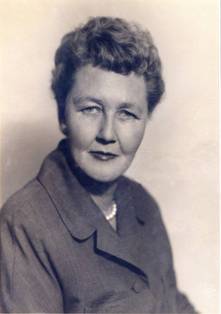
Marty Mann
- Some of the earliest programming was started by Marty Mann and the National Committee on Alcoholism. Do you have any insight or personal or secondhand accounts of what she did and how it influenced the development of recovery capital in your area?
It was the first organization in the nation formed to provide education and advocacy, initially on alcoholism and later to include other drugs. It was known initially as the National Committee and then became the National Council on Alcoholism (NCA) and finally the National Council on Alcoholism and Drug Dependence (NCADD). You mentioned that the city you grew up in (Bethlehem) had one of the first and that it was operational by the mid-1950s. By the 1960s, nearly every county had one in Pennsylvania one and in that era, they were known as local affiliates. Some states also had state affiliates. There were requirements to be an affiliate, including having a 24/7 call line to provide information and support for persons experiencing problems with alcohol. These lines were generally staffed by volunteers and connected people into local recovery support fellowships. No other organizations were focused on these highly stigmatized issues in that era. They educated people about alcohol and helped them find services. They helped develop recovery capital and communities of recovery advocates around the nation. Everything that came afterwards was built on this foundation.
In Bucks County, that affiliate led to the formation of the Council of Southeast Pennsylvania, Inc. When we look back to the establishment of funding through the federal block grant nationally through the efforts of Harold Hughes in the US Senate, it was these organizations all across the country who she connected with to advocate for funding to support that groundbreaking legislation that led to the development of our whole field.
The efforts of Harold Hughes would not have borne fruit without the work of Marty Mann through NCADD that started a generation earlier. Hughes asked her to testify at public hearings at the request of Senator Harold Hughes, and set in motion legislation that pioneered research on women’s treatment programs, that eventually established residential care for women and their children. Bill White wrote a post titled Honoring Recovery Ancestors a few years back that has a picture of them together. There are some really great pictures of early recovery leaders and their association with NCADD that can be found here.
In Pennsylvania Milton Berkes from Bucks County spearheaded efforts to develop a service infrastructure for that federal funding as it came down to the state. His signature legislation was Act 63 of 1972 which established the funding and service infrastructure. At the county level, this led to the establishment of the single county authorities. Early discussions included elevating the NCADD local affiliates to act in this role but it in most instances this did not happen. One of the SCAs, The Council On Chemical Abuse in Berks County has its origins in an NCADD affiliate. When I look back at that era, the local affiliates that came out of her work had significant influence on the way that services were developed in that era across our state and the rest of the nation.
Thinking back to those times, I recall that there was a lot of discussion about what it meant to be an affiliate. There was a lot of sharing and collaboration amongst these entities here in PA and beyond. As the National Council grew, there was a sense that it was no longer representing the needs of the local affiliates consistently. This was in a period in which a few well to do board members of NCADD with strong views held sway over the direction it took. The areas they focused on at times did not always mesh with the interests of the local affiliates. There was some push back to national to become more representative of local affiliate interests. These are dynamics we see in organizations across history in our space.
I think that at the time she was fighting stigma and educating the public about Alcoholism she not only was doing groundbreaking work, but she publicly used her own lived experience as part of that effort. This was highly controversial for anyone but particularly for a woman. anonymity was sacred and she was speaking out publicly. The power of our stories was recognized but not at the level of the press or other media. Women were certainly the minority in AA at the time and a woman that showed leadership, strength, courage and had power did not get positively recognized or get credit for what they accomplished in the 1950’s and still many times today. She also was surrounded by powerful men that I believe she gave the credit to in order to continue their support (financial and other). We owe a lot to her as well as many of the other early pioneers . I feel a great sense of gratitude to Marty Mann for the foundation of work she did to create an organize the grass roots community to fight to reduce stigma and educate the public. What she started led the way for today’s Recovery Community Organizations. We as a field are in a better place because of her work.
- Is there a particular moment or memory or secondhand account that stands out to you in respect to those early days and early pioneers that you would like to share?
Marty Mann had an incredible work ethic. She tirelessly traveled across the country to educate people that alcoholism was a disease and not a moral failing. She worked to advance science to support our understanding of alcoholism. She contributed immensely to our current understanding that people like us deserved compassion and help. We do get better! She was the pioneer who took on stigma and shifted public perceptions. This was particularly true for women, who face extra stigma in our society. When we think today of all of our efforts to put a face on recovery, we owe a great deal to Marty as she traveled America and spoke about the need for compassion. She really knew how to capture people’s imagination and to mobilize our community.
All of her early objectives emanated out of three ideas that are now well accepted but in that era were viewed as revolutionary. Those three concepts were:
- Alcoholism is a disease and the alcoholic a sick person.
- The alcoholic can be helped and is worth helping.
- Alcoholism is a public health problem and therefore a public responsibility.
Her work to establish Alcoholism as a medical condition led to the formation of the New York City Medical Committee on Alcoholism in 1951 with Ruth Fox, the first medical director of the National Council on Alcoholism. This eventually led to what we now know as the American Society for Addiction Medicine (ASAM). She helped start the very foundational institutions we have today. At the same time, she established local committees of “concerned others” to provide resource centers where people with alcoholism could find help.
- How did you get into this work? Can you see how it connects to her efforts? How did this influence your work in the recovery space?
I got into recovery in 1971 and was involved in a local church. There was an interest in helping people within the faith community. Before I had gotten into recovery, I had worked for the phone company. I knew how to connect and engage with people on the phone. It was a skill set that was seen as useful, and I was recruited as a volunteer by a Presbyterian minister by the name of John Sparr. Stepping into service changed the direction of my whole life as happens for so many of us.
This was part of a network of such efforts occurring in the Presbyterian church that could never have occured had Marty not initiated her efforts to normalize alcoholism and get people help. It may be hard for people now to understand how revolutionary it was to have these conversations in the faith community. We started talking about what had been a taboo subject and people responded. We helped a lot of people just by talking about alcoholism, which had been seen as a topic too shameful to discuss before Marty. Our efforts grew from there.
We ended up pulling together a number of committed and likeminded individuals and eventually, my volunteer work turned into a paid position in the newly formed the Council of Southeast Pennsylvania in 1976. I was hired as the volunteer coordinator. The only other position was secretary. As it started to come together, there was a desire to bring in an experienced leader and the Board conducted a national search.
They found a number of qualified individuals but realized that they could not afford any of them, so they offered me the position. I accepted. We built it from that point into an agency serving multiple communities. I was the Executive Director for 42 years until I retired in 2018. Building it up and serving our community was my life work. We were the NCA affiliate, those seeds sewn by Marty Mann in the mid-1940s ended up taking root in our community and quite literally thousands of lives have been transformed. She laid our foundation as she did for so many organizations like ours across the nation.
- Are there any lessons we can learn from the arc of the NCADD and its successes and struggles? Are there lessons for us now?
As we have talked about so far, Marty created and then cleared the path in so many ways. It is also true that there were a lot of challenges. She helped found the Yale School of Alcohol Studies in the 40s, but there were politics with the school that led to changes. Because of a lack of funding, the school moved to Rutgers. Funding was a perennial problem for the National Council from its very inception. In the early years, Marion Barbara ‘Joe’ Carstairs helped keep the doors open and R. Brinkley Smithers later stepped in to write checks to help the NCA fulfill its mission. General funding drives to the public failed to yield significant donations, which placed the organization in a precarious position. This was then and is now a result of stigma; our condition does not garner widespread philanthropic support. Fundraising is still a huge challenge for organizations in our space today. There is not much in the way of private charity in our space. It just does not have the same appeal as a cure for cancer support or children-oriented service organizations. We still need to change that in America.
In part because of the way the organization was funded, the small group of people writing the checks had significant sway over the direction of the organization. At times it got sidetracked. As I noted in a prior question, local affiliates did not feel heard at times. The national office became worried that the organization may splinter as the local affiliates asserted their views. This was a fate they avoided, probably in no small part to Marty and her ability to draw people together. We see these dynamics in our era as well. We need to avoid being splintered and to sustain common purpose to be effective. History is not linear; we can lose the gains we have made.
There were also some rapid shifts in leadership as the organization attempted to secure funding. In 1968, the NCA Board hired William W. Moore, Jr. to succeed her and Marty Mann became founder-consultant. He had headed the American Heart Association and came to the NCA with a background in management of a large, voluntary health organization. He ended up pulling the organization in a different direction. George C. Dimas replaced him in 1972. It can be the case that organizations struggle when pioneering leaders transition as new leaders may have very different visions. Marty remained a visible leader during these times and beyond, and it may have led to some conflict of confusion. During this era, Marty was focusing all her energy helping Harold Hughes pass the historic Hughes Act on December 31st 1970 on the very last day it could be enacted into law.
Since its early days, there were varying views on how to define and treat alcoholism, and these internal struggles may have made sapped its energy or made it seem less coherent as viewed externally. We certainly see similar dynamics with infighting and division now. It is interesting to note that in the early days of NRAM, when we all were working towards established goals, we achieved some of our greatest successes.
- What would you tell future leaders about what you have from your decades of service to our community?
The constant in this work is that it is built on foundations of help, hope, heart, and healing as a constant. NCADD required all Affiliates to have a Help line usually answered by a person in recovery. Help and Support are important elements in building hope, and it is important that future leaders understand that. They are foundational components. These elements work at every level. In addiction we are without hope. Through recovery, we get hope, we heal, and we get heart for life and often commit to service. We then help others heal and gain hope and heart. We thrive when we are able to do these things for ourselves and in service to others, and when we do this whole communities heal. We call this recovery capital. It has also always been about fostering these elements in community. We need enough funding to appropriately fund Recovery Community developed and led recovery support to help folks initiate and sustain long term recovery. Quality clinical treatment for those who need it, honest behavioral health services designed to meet the needs of those with co-occurring disorders and services designed to meet the needs of specific populations, people of color, women, older adults and youth. We need to change this thinking on a policy level so that resources go to community building efforts instead of treatment-oriented services. It can be really hard for people who are used to the treatment orientation to even understand this. But it is what has always worked.
There has also always been an inherent disdain for people experiencing substance use disorders in our society. We are a marginalized community. There are very real dynamics of oppression that occur, and it can get demoralizing for people who work to change it. There are also dynamics in marginalized communities to divide and fracture, to go after each other to be seen as more favorable or simply because of the pain and trauma associated with experiencing discrimination hurts people and they channel it in ways that hurt others. These dynamics must be overcome for any marginalized community to accomplish its goals, including ours.
Our own history bears this out. When we come together in common cause, we do great things. When we fracture, we become less effective, and we lose ground. One of the resources that future leaders have that we did not have to the same degree in our days is that we are starting to document our history and have the opportunity to learn from it. When the new recovery advocacy movement was born a generation ago, William White had just published Slaying the Dragon. We were very aware of how fragile what we had was and how important it was to find, protect and work on common goals. That is still very much true today. The work of Marty Mann and the history of that era shows some of the very same patterns of challenges we face now. I would tell young leaders to study and learn from our history and find common ground to work on together to take us forward to new heights.
The world’s veteran, currently serving, and first responder communities are filled with brave, strong, and honorable individuals. They are true heroes and inspirations for all of us.
Some of these individuals also display bravery by their commitment to recovery from substance addiction, mental health disorders, and maladaptive behaviors. To honor and recognize their efforts, SMART has created an International Veterans & First Responder’s Webinar. This free event is open to all veterans, currently serving, and first responders across the globe—and those who wish to show support and solidarity with these communities.
Please join us for this historic event and celebrate Life Beyond Addiction.
Saturday, November 12th at 4:00 p.m. EST, 9:00 p.m. GMT
& Sunday, November 13th at 8:00 a.m. AEDT
If you are a veteran, currently active, or first responder, we encourage you to take this survey about your experience. The results will be discussed at the webinar.
PLEASE NOTE BEFORE YOU COMMENT:
SMART Recovery welcomes comments on our blog posts—we enjoy hearing from you! In the interest of maintaining a respectful and safe community atmosphere, we ask that you adhere to the following guidelines when making or responding to others’ comments, regardless of your point of view. Thank you.
- Be kind in tone and intent.
- Be respectful in how you respond to opinions that are different than your own.
- Be brief and limit your comment to a maximum of 500 words.
- Be careful not to mention specific drug names.
- Be succinct in your descriptions, graphic details are not necessary.
- Be focused on the content of the blog post itself.
If you are interested in addiction recovery support, we encourage you to visit the SMART Recovery website.
IMPORTANT NOTE:
If you or someone you love is in great distress and considering self-harm, please call 911 for immediate help, or reach out to 988 Suicide & Crisis Lifeline @ 988, https://988lifeline.org/
We look forward to you joining the conversation!
*SMART Recovery reserves the right to not publish comments we consider outside our guidelines.*
Guest blog by Natalie Umesi, MD, MBA, SMART Recovery NYC Women’s Meeting Facilitator
I feel honored to be a SMART Recovery facilitator. I facilitate local meetings with a group of warm, supportive, and dedicated individuals, led by “G” (Matamoros), who is impossible not to love at first introduction. While enjoying our SMART Recovery NYC annual Watermelon Social this summer, we discussed the importance of offering two recovery meetings that meet the needs of our diverse population.
I started SMART Recovery NYC’s first women-only meeting, open to all who identify as a woman. My hope is to create a safe space to address the unique biological and societal challenges that women face in accessing addiction treatment and in recovery from substance use disorders and other maladaptive behaviors. I love the space that we have created in our weekly meeting. We celebrate our collective successes, we support each other through challenging times in a nonjudgmental setting, and above all, we use the CBT-based SMART tools so that we may continue to take agency in our lives.
While I am excited that the meeting attendance has grown and that there are consistent participants whom I look forward to seeing each week, I do wish that there were more opportunities for women to join women-only meetings in the area. I am based in Brooklyn, NY, and have had (online meeting) participants from Colorado, Florida, and even Washington state! There appears to be shortage of these meetings, which limits the opportunity for women to engage in peer-supported meetings where it is relevant and welcomed to discuss topics such as motherhood, hormonal changes, relationship dynamics, intimate partner violence, childhood trauma, and even gender-specific biases in the workplace that play a role in recovery. I am not a “meeting loyalist.” I often tell participants in our meeting to find a program that works, and that if our meeting is not working for them, I will help them find a meeting that does. Unfortunately, there are few alternative women-only meetings.
Fortunately, attention to the importance of access to mental health resources and substance use disorder treatment has significantly increased over the past decade. It is my hope that this attention will also highlight the gender-specific disparities in substance use disorder treatment and promote the increase in gender-specific support groups to function as an adjunct to formal mental health treatment. In addition, SMART meetings provide support for those with financial insecurity and those who are in the process of finding a therapist or psychiatrist. If there are SMART Recovery facilitators interested in starting a women-only meeting, please reach out to the Volunteer Support Department at [email protected] for support and guidance.
Find additional SMART women-only meetings and resources:
PLEASE NOTE BEFORE YOU COMMENT:
SMART Recovery welcomes comments on our blog posts—we enjoy hearing from you! In the interest of maintaining a respectful and safe community atmosphere, we ask that you adhere to the following guidelines when making or responding to others’ comments, regardless of your point of view. Thank you.
- Be kind in tone and intent.
- Be respectful in how you respond to opinions that are different than your own.
- Be brief and limit your comment to a maximum of 500 words.
- Be careful not to mention specific drug names.
- Be succinct in your descriptions, graphic details are not necessary.
- Be focused on the content of the blog post itself.
If you are interested in addiction recovery support, we encourage you to visit the SMART Recovery website.
IMPORTANT NOTE:
If you or someone you love is in great distress and considering self-harm, please call 911 for immediate help, or reach out to 988 Suicide & Crisis Lifeline @ 988, https://988lifeline.org/
We look forward to you joining the conversation!
*SMART Recovery reserves the right to not publish comments we consider outside our guidelines.*

Addiction isn’t a spectator sport, eventually the whole family gets to play
One of the things that still haunts me, years into recovery, is the memory of the impact of my addictive behaviour on others – particularly those I love but also my colleagues. There was plenty of suffering to go round, the debris spread far and wide. In some ways the cleaning up operation has never quite concluded.
This experience of ‘collateral damage’ is true for most of us who have experienced addiction, yet research is relatively restricted on the phenomenon, despite the fact that the impact on third parties may be as great (or greater) than the impact on the person with the substance use disorder.
It was interesting then to read a study from Germany,[1] published in the journal Addiction, which looked at the impact of addictive disorders on family members and how this affected their health and mood. Previous studies have shown that relatives can have increased problems with mental health, injuries, higher use of healthcare services and loss of productivity and that these negative consequences are improved by abstinence.
This was a big study involving almost 25,000 people living in Germany. The researchers wanted to get a feel for the proportion of family members impacted in the general population and how severe those impacts were. In this representative sample of people 15 and older, they found that almost 10% of individuals had a relative with an ongoing addictive disorder problem in the last year. A further 4.5% reported that they had a relative with a past dependency. They found that alcohol was by far the most common drug causing problems (80%), followed by cannabis (16%) and other illicit drugs (12%).
Family members affected by addictive disorders had higher levels of depression (doubled) and lower levels of self-rated health. Family members also had higher rates of smoking and risky or binge drinking. There was the suggestion of some good news though relating to the impact of recovery from dependence:
Findings suggest a strong association between the recency of the addictive disorders and ill-health and depression and correspond to the results of analyses from the United States based on health insurance data, which suggest that the psychosocial burden on partners of males with an alcohol use disorder decreases after successful treatment.”
Bischof and colleagues, 2022
I fear we do not pay attention enough to this in our research and practice even though Government Policy in Scotland emphasises the needs and role of family when we consider how we deliver treatment. The recently published final report of the Drugs Deaths Task Force recommended the adoption of a whole family approach and that families should have their own specific support for wellbeing and psychological health.
When families are not considered as part of an evaluation of the impact of treatment, we are missing something very important. Recovery may or may not include abstinence, but measures of recovery progress ought to include the positive gains family members and loved ones make as the individual with a substance use disorder recovers. How well do the families of the people in alcohol and drug treatment in Scotland fare?
A few years ago when I was part of a group supporting the production of the Independent Expert Review of Opioid Replacement Therapies in Scotland, I had an opportunity to take evidence from family members of those with substance use disorders members attending a national conference. It was a bruising experience. Families were not happy with the care on offer at the time.
At the end of the session, although I had gathered a wealth of evidence for feedback, I was left feeling responsible for all of the sins of the treatment system. It was not easy to hear the experiences of people who felt they had let down. The message was clear, family members felt excluded from treatment decisions, did not generally support opioid substitution (though they liked buprenorphine more than methadone) and felt stigma stopped them coming forward.
“The needs of the relatives, friends, co-workers and communities affected by the drinking of people in their social networks are seldom voiced, counted or responded to.”
Brian Coon, writing on this blog last year, picked up some themes that are relevant to this. Commenting on a paper that showed improvements in those with alcohol use disorder who cut back on their drinking but continued to drink heavily – arguably a kind of recovery – he references Kelly and Bergman[2] who point out that heavy drinking can continue to impact on families and that their needs have to be taken into account.
Brian highlights the danger of separating research data from experience. If we are too narrow in our exploration we will not see other things that are important. We are not islands, we are connected into rich social networks, including our family members. Our behaviours affect others. A finely focussed microscope is a limited tool when the big picture is what matters.
Classifying someone as being in successful “recovery” due to the fact that they appear to be functioning but while engaging in very heavy drinking, ignores the potential collateral damage to close significant others (eg, children, partners), whose well-being can be severely impacted by the enduring unpredictability of heavy use. – John F Kelly, Brandon G Bergman
Of course, family members’ recovery ought not to be dependent on the recovery of their loved one. In the residential rehab service I work in, we have a family programme running alongside the patient programme. This is aimed at supporting the families of those we treat. While most people in the treatment programme will go on to complete it and most of those who complete it will find sustained recovery, we have the philosophy that the wellbeing of the family members is not contingent on how well their loved one does – that families can improve their emotional and physical health by mutual support and self-care regardless.
Families can also be supported through mutual aid groups like AlAnon and via local and national support groups. I think the therapeutic effect of family members coming together and supporting each other is very powerful – perhaps more so than one to one support.
In Scotland, the national organisation, Scottish Families Affected by Drugs and Alcohol captures this ethos in their impact report. I’ll finish with a quote from it because I can’t say it better than they do.
“Being able to enjoy a relaxed family meal, ignoring your phone for a while, giving yourself permission to go for a walk or meet a friend for a coffee, or joining a class or a group for the first time are all huge steps for family members. Their everyday lives have been wholly shaped and controlled by their loved one’s alcohol or drug use, often over many years.
Working with families to learn new ways to communicate and interact, be confident in setting boundaries, prioritise self-care, and understand more about substance use and recovery really does change lives and save lives.”
Amen to that.
Continue the discussion: @DocDavidM
Picture credit: Oatawa istockphoto, under license
[1] Bischof G, Bischof A, Velleman R, Orford J, Kuhnert R, Allen J, Borgward S, Rumpf HJ. Prevalence and self-rated health and depression of family members affected by addictive disorders: results of a nation-wide cross-sectional study. Addiction. 2022 May 31. doi: 10.1111/add.15960. Epub ahead of print. PMID: 35638375.
[2] Kelly JF, Bergman BG. A Bridge Too Far: Individuals With Regular and Increasing Very Heavy Alcohol Consumption Cannot be Considered as Maintaining “Recovery” Due to Toxicity and Intoxication-related Risks. J Addict Med. 2020 Oct 14. doi: 10.1097/ADM.0000000000000759. Epub ahead of print. PMID: 33060467.
Years ago, Brett Macdonald and his friends had the time of their lives backpacking across Australia. After many conversations, they realized that heavy alcohol use had become a staple in their lives. This led them to creating a “sober competition” to see who could abstain from drinking the longest. From this, a global fundraising and awareness initiative was born. Brett is now the Managing Director of EzyRaise, a global fundraising platform, whose campaigns include Dry July Australia, Take on Addiction, and the latest, Sober October USA.
In this podcast, Brett talks about:
- The history of Sober October campaigns in other countries
- How SMART Recovery became the partner and beneficiary for the US campaign
- Why and how to get involved with Sober October
- The benefits of abstaining from alcohol
- Coming to your own conclusions about alcohol
- Useful features for participants, including an alcohol calculator and calendar
- There is still time to join Sober October and support those in recovery
Click here to find all of SMART Recovery’s podcasts
PLEASE NOTE BEFORE YOU COMMENT:
SMART Recovery welcomes comments on our blog posts—we enjoy hearing from you! In the interest of maintaining a respectful and safe community atmosphere, we ask that you adhere to the following guidelines when making or responding to others’ comments, regardless of your point of view. Thank you.
- Be kind in tone and intent.
- Be respectful in how you respond to opinions that are different than your own.
- Be brief and limit your comment to a maximum of 500 words.
- Be careful not to mention specific drug names.
- Be succinct in your descriptions, graphic details are not necessary.
- Be focused on the content of the blog post itself.
If you are interested in addiction recovery support, we encourage you to visit the SMART Recovery website.
IMPORTANT NOTE:
If you or someone you love is in great distress and considering self-harm, please call 911 for immediate help, or reach out to 988 Suicide & Crisis Lifeline @ 988, https://988lifeline.org/
We look forward to you joining the conversation!
*SMART Recovery reserves the right to not publish comments we consider outside our guidelines.*
Subscribe To Our Blog
Join our mailing list to receive the latest news and updates from the SMART Recovery Blog.
You have Successfully Subscribed!

Recovery journeys are rarely linear, generally bumpy and often happen over many years. Treatment may or may not be part of the process. People can need several different treatment episodes over time, often re-presenting with different needs and goals.
Despite a growing evidence base only a small percentage of treatment episodes take place in residential rehabilitation settings in the UK. Access is not easy. In many parts of the country – to get to rehab you need to be wealthy, insured or just plain lucky. If you have the wrong postcode and no funds, you may never get there.
If you are fortunate enough to find your way to rehab, you are less likely to reach your goals if you don’t get sufficient time in treatment and if the intensity and content are not robust. Evidence suggests, that to get the most gains, treatment should last at least three months.
One thing that predicts positive outcomes is the quality of what happens after rehab. If recovery journeys happen over years, then it makes no sense to put most of the energy into the residential treatment episode at the expense of ‘aftercare’. Any aftercare provided by rehab should be strongly focussed on helping individuals develop their own support systems and connecting them to services which will help in the longer term – and by longer term I mean the rest of their recovery. Yet this area of ongoing support is something that is not always as well developed or as valued as highly as it might be.
The Scottish Government’s Good Practice Guide on residential rehab pathways recognises this:
Residential detoxification and rehabilitation programmes should not be seen as stand-alone interventions, but rather as components of an integrated package of care. Adequate preparation and after-care provided in community settings are key to the success of residential treatments.
Recently, Professor David Best, writing in his blog, picks up this topic in an insightful way. He emphasises the importance of making new links to community recovery resources like mutual aid and lived-experience recovery organisations (LEROs) which can then generate new, protective social networks. He points out that to do this we need to build effective bridges from treatment to such organisations. Further, nonspecific resources (like clubs, colleges and classes) should also be seen as rich materials with which to build recovery capital.

One challenge with realising this is what Professor Best calls the ‘house on the hill’ model of rehab. This is the traditional set-up where the person is taken away from their environment to treatment in a distant facility. Sometimes people stay in the area where the rehab is situated. Other individuals will return home after treatment. I don’t believe we have data on the division.
While there are positives to out of area placements, one potential disadvantage is that if the person does return to where they came from at the end of treatment, the capacity of the rehab (and of local recovery resources) to support them may be limited, though digital developments can help. Rich local connections which may have been generated and developed during treatment are not going to help someone leaving the area to go home.
The challenge remains that for many people the departure from a residential rehab, is one from high social recovery capital (within the rehab) to low or negative social capital (particularly if returning to areas where most of the available network involves people who are still using).
Professor David Best
There are examples (in Scotland) where local initiatives are overcoming these obstacles (e.g., rehabs which focus on local populations or where a community service supports individuals prior to and after the rehab placement making those connections actively). While good practice exists, there is still a lot of room for development of a joined-up system of care that puts as much effort into what happens after treatment as what happens during it. This is not only a problem for rehabs, but also an issue for commissioners who are allocating funding for distal placements.
Prof Best sets out three measurable conditions to test the benefit of out of area placements:
- Only commissioning residential treatment providers who have a strategy for engaging community capital in their later stages of treatment.
- Building effective bridges from the recovery residence to local community recovery resources for those returning.
- Having an adequate set of recovery resources available and accessible in your area to sustain and further build the recovery capital gains achieved in residential treatment.
There is little to disagree with here and so much to endorse. From what I know of rehab providers in Scotland, I think most, if not all, are switched on to the value of active connections to community resources,. The tricky thing is to become aware of and develop links to multiple organisations across a wide geographical area. Perhaps reciprocal arrangements could be developed. The service I work in, for instance, offers aftercare to patients returning to Lothian from out of area rehabs.
There is a further issue with the relocation of out of area rehab clients. Each time this happens, we are losing a huge asset to communities in home towns and cities. A person in recovery acts as a beacon of hope, a role model, and a bridge for those seeking recovery. When recovering people are not available to their own communities, something very important is squandered.
In the situation where individuals are going to return home from an out of area rehab, commissioners and providers will want to ensure that robust connections are made during treatment and that afterwards these supports continue. Auditing uptake and engagement of local resources in the short/medium term ought to be simple to do and could be reported as quality measures – something that is almost certain to improve outcomes for those going through rehab.
Continue the discussion on Twitter: @DocDavidM
Photo credit: Glencoe, Nathan Chung

“Human beings have a strong dramatic instinct toward binary thinking, a basic urge to divide things into two distinct groups, with nothing but an empty gap in between. We love to dichotomize. Good versus bad. Heroes versus villains. My country versus the rest. Dividing the world into two distinct sides is simple and intuitive, and also dramatic because it implies conflict, and we do it without thinking, all the time.” ― Hans Rosling
People really do tend to see things all one way or all another way. In psychology, this is also known as splitting – a defensive mechanism in which we tend to see things in all or nothing terms, often in contradictory ways. This includes how we conceptualize substance use and addiction. It has huge policy implications in the realm of drug policy. We adopt strategies that move us in different directions for different communities, sometimes at the same time. We flip between patterns of more permissive use and then back to punitive approaches. We view addiction as entirely related to trauma and social or economic disparities, or simply a result of bad decisions made by people making a conscious decision to purse self-destructive choices. Yet, we know that substance use, and addiction is a far more complex topic with a broad range of variables.
Substance use leading to addiction has complex psychosocial and genetic facets and occurs across all socioeconomic classes. Kids decide to use drugs with brains not able to make fully formed decisions for a variety of reasons, including trauma and even simple experimentation. Kids who experiment and have the wrong genetic loading can rapidly become addicted. Some people can use with little consequence, others can experience problems, and some become addicted, and use leads to death. Use rests on a continuum with a myriad of variables. No simple answers here.
We have no panacea to addiction, yet we want single focus solutions for an incredibly complex condition that defies easy resolution across that continuum of use and risk of consequence. This is perhaps the truest in respect to cannabis, which is portrayed as either a panacea or the devils lettuce depending on the era and who you ask.
Oversimplifying of Cannabis policy has huge consequences. Historically, we created moral panic, and these efforts backfired. Consider the 1936 movie Refer Madness, an anti-drug propaganda film intended to scare the hell out of kids so that they would never use. The film depicts kids lured into using cannabis, rapidly turned into depraved lunatics who engaged in rape, murder and suicide. Like many white kids in my era, I used to watch the movie as entertainment while getting high. I saw the overstatement of risk as cause to discount any and all such claims by adults. Drug experimentation for many white kids in my era was something of a right of passage with little consequence. But we also put in place mandatory sentencing guidelines applied in a disparate fashion. We locked up our black and brown brothers and sisters and caused intergenerational consequences that remain daunting to overcome in these communities.
We see these same dynamics work in the other direction. Cannabis as a cure all. It has recently been touted as a treatment for PTSD, although the research does not support this, and even suggests it to potentially harm PTSD healing efforts. Cannabis is being falsely claimed as a cure for cancer. We even moved to use cannabis as a treatment for opioid use disorder in a few states, including in my home state of Pennsylvania despite the lack of evidence for its use even in this way and with growing evidence that such polices have fueled addiction.
Overstate the benefits and understate the risks, it is age old play book used by the makers of addictive drugs. For companies and cartels alike selling drugs, these strategies make sense. Exploit every opportunity to sell your drug and make money. In contrast, prohibitionists overstate the risks to create fear and that fear is used to target marginalized communities for increased sanctions. The consequences of binary thinking. We need a more balanced approach. We need to address the risks, reduce addiction, and get people help without resorting to punitive measures or simply locking people up. A nuanced approach, not a binary “all one thing or the other” policy applied in a disparate fashion.
The current administration had moved to pardon the 6,500 people who have been incarcerated for simple possession of marijuana. It was a mark on their record for life. It was the right thing to do. We have learned through the opioid epidemic that the war on drugs is a war on American families. We saw this when addiction started impacting white rural America, and it makes sense to change our polices in ways that support all families, not just white ones. We need to work to undo harms like this even as we work to protect the next generation from developing substance use problems.
One of the truths is that there is a significant increase in societal harms as a result of more permissive, high potency cannabis. In the same breath, it is a drug that many people can use in moderation without significant consequences. We are seeing this even as we come to terms on how drug war polices around cannabis have harmed entre communities.
Consider that there is a growing association between heavy cannabis use and being a victim or perpetrator of intimate partner violence. We are seeing a one in five increase in the odds of hospitalization among recreational cannabis users and even deaths from cannabinoid hyperemesis syndrome (CHS), aka scromiting among other growing risks. Which brings me back to the title of this article. How do we address, or even talk about these things rationally and find the right balance to address harms yet not move back to blanket prohibitions and overly punitive strategies applied disparately?
One of the models that gets held up is the Portugal model. Portugal is a European nation of 10 million people that has moved to address addiction as a public health issue. Drug use has been decriminalized, yet drugs are still confiscated, and possession may result in administrative penalties such as fines or community service. Having larger amounts of drugs can and does lead to incarceration, with one factor in the sentencing consideration being if people are selling the drugs to support their own use. Mandatory help can be required for drug users as evaluated by the local Commission for Dissuasion of Drug Addiction, which can fine or even take people’s property when they continue using drugs harmfully. Unlike the United States, where a handful of people who need help can access treatment often after long waiting periods, treatment is available on demand in Portugal. Most stories of what Portugal has done lack these details on measures of control and highlight the decriminalization elements. Our oversimplified view of Portugal is problamatic.
Here in America, we face dynamics of commercialization of drugs that is not present to the same degree as in European nations like Portugal. We only need to look as far as the opioid epidemic, fueled by bogus research like the infamous pseudo-addiction study led by Purdue Pharma Vice President of Health Policy Dr David Haddox and marketing strategies that took advantage of concepts like pain is the fifth vital sign to expand drug sales. They even weaponized stigma and blamed people who became addicted in order to bank their massive profits off the suffering of American families. These are patterns in our own history to pay attention to at this juncture as we consider cannabis use policy.
In a world that sees things in binary terms, we need nuanced policy around cannabis use, cannabis control, cannabis treatment and cannabis recovery strategies. Cannabis is not harmless, it is not a panacea for a myriad of ailments, but nor is it a drug that turns people into depraved lunatics, although we are seeing increased levels of psychosis for heavy users of high potency strains. We need policies that keep cannabis out of the hands of kids who are at greater risk to become addicted to it, strategies to reduce risks of it being a factor in cannabis related highway deaths and awareness in our communities that this is a drug that is not without significant risks to our society.
The danger of saying these things or suggesting rational policy is to risk getting marked as a prohibitionist. This is also a strategy fueled by big cannabis and other addictive drug merchants to dissuade policy development that reduce sales. Heavy users are their best customers. The dynamic in industries working in the addictive drug space is to maximize and capitalize profits while hiding and socializing the consequences. We end up blaming those who get addicted as a result.
So, what should we do? A partial list of areas of focus for nuanced, non-binary thinking policy development:
- Addressing problematic use from a medical lens rather than a criminal justice lens across all communities
- Restricting access and marketing of cannabis to young people as they are more vulnerable to addiction
- Truth in marketing about the risks of cannabis use across our society
- Objective research on risks of cannabis for people in recovery from other substance use disorders
- Objective, longitudinal studies on the long-term consequences of more potent cannabis that is present today
If we want something different, we need to do things differently. Over the course of American history, we have tended to flip into overly punitive drug use policies in response to substance use related consequences as harms become more prevalent. Our capacity to have nuanced policies are made more challenging as a result of industry related influence on how we think about, and address substance use in our society.
We face of growing evidence that we are under emphasizing the consequences of more potent and accessible forms of cannabis. Unless we address these developments, we will flip once again into a “lock them up” mentality in respect to persons who find themselves experiencing consequences. Particularly in marginalized communities. If we are to avoid that, we need to figure out ways to shift away from binary thinking in respect to drug policy and develop far more nuanced solutions accepted across the political spectrum of thought, and even greater challenge in our polarized era.
Substance use and addiction are highly complex issues requiring a wide range of responses. Are we capable of doing something different than what we have in the past? The only way to know is to try. Good things have always been hard.

